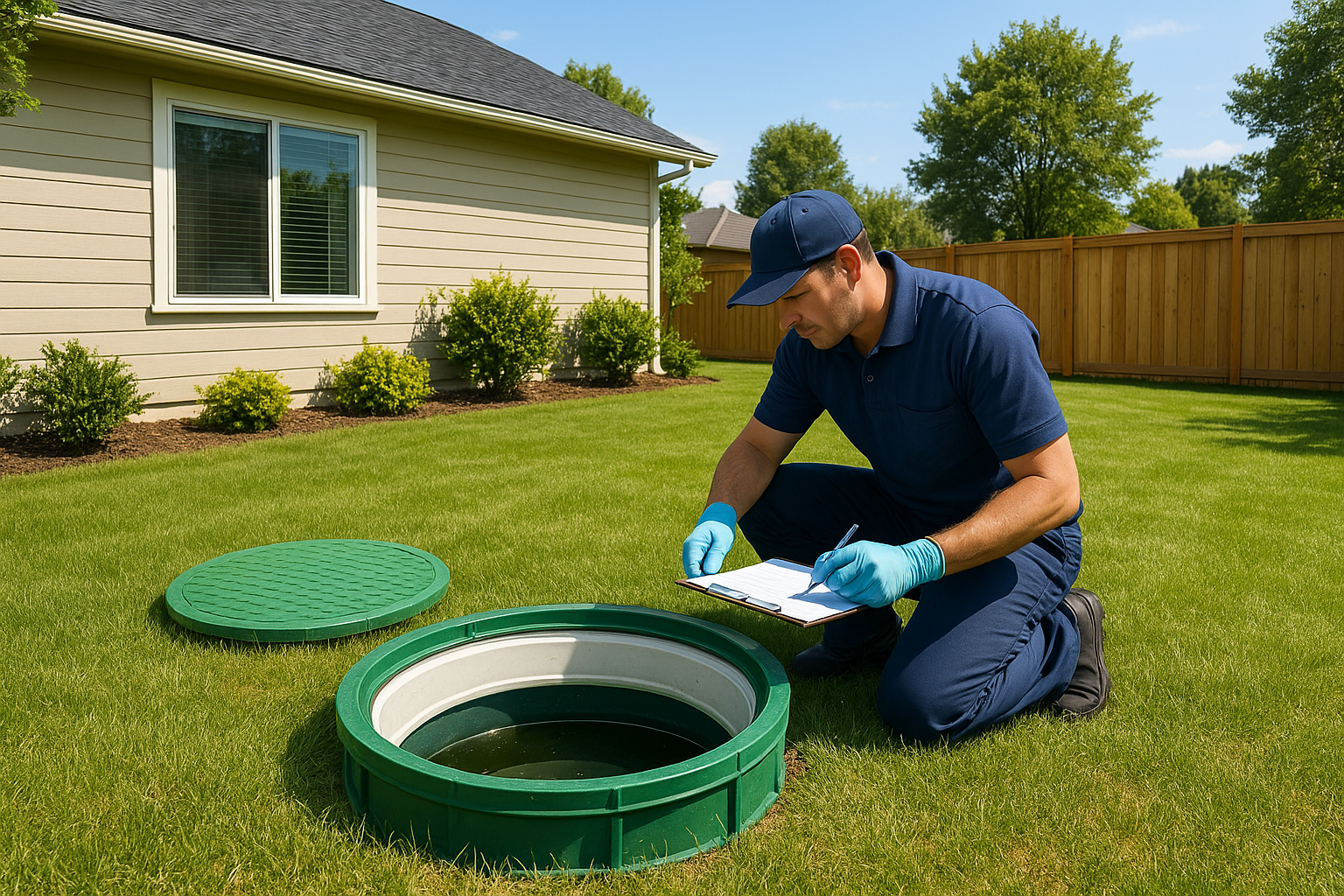If your home uses a septic system, regular septic tank emptying is one of the smartest ways to prevent backups, bad smells, and surprise repair bills. A septic tank separates wastewater into layers, but solids and grease keep building up. If the tank is not emptied on time, sludge can reach the outlet, clog the drain field, and send wastewater back toward your sinks and toilets.
Most households need routine pumping on a set schedule that fits their usage. A simple plan gives you a cleaner yard, safer plumbing, and lower lifetime costs. Blue Ribbon Septic can handle the dirty work and keep your system healthy with friendly, expert service.
This guide explains how a septic tank works, the signs it is time to schedule sewage tank emptying, how pros handle cleaning a septic tank, and what affects septic tank emptying cost. You will also learn the safe answer to common questions such as how to empty a septic tank, how to drain a septic tank, and how often a septic tank needs emptying. We keep the language simple and the steps practical, so you can take action today.
Quick Take: Why This Matters
- Backups are expensive and stressful. Planned septic tank clean out avoids emergency calls.
- Healthy tanks protect the drain field and your yard.
- A steady schedule for pumping a septic tank helps parts last longer.
- Blue Ribbon Septic makes service simple with reminders and clear checklists.
What Is Septic Tank Emptying
Septic tank emptying means removing the scum and sludge layers from the tank with a vacuum truck and disposing of the waste at an approved facility. It is different from a one-time septic tank clean out for clogs. Emptying is routine maintenance, while a clean out is an urgent fix when a line is blocked.
Some homes also have lift equipment to push wastewater uphill. That is a lift pump station or a lift station for septic systems. The focus here is the septic tank itself, though the lift equipment may also need service. If your home uses a wastewater lift station, ask Blue Ribbon Septic to align both schedules when we plan your maintenance.
How Septic Tanks Work
A septic tank takes in wastewater from the home, slows the flow, and lets solids settle.
- The top layer is floating scum, often fats and oils.
- The middle layer is liquid effluent.
- The bottom layer is sludge, which grows over time.
Cleaning a septic tank removes the scum and sludge so the outlet baffle does not pass solids into the drain field. If solids pass through, they can clog the soil and shorten the life of your system. Good maintenance keeps solids where they belong, inside the tank, until they are pumped out by a professional.
How Often Does a Septic Tank Need Emptying
There is no single date that fits all homes. Frequency depends on people in the home, tank size, water use, and habits like using a garbage disposal. Many households fall in the three to five year range for septic tank emptying, with inspections every one to three years to confirm the level and timing.
Use this simple approach:
- Get an inspection to measure scum and sludge.
- Set a calendar reminder based on the inspector’s reading.
- Adjust if your household size changes or water use increases.
Some health departments and university extensions show how a two person home with a 1000 gallon tank can go longer than a large family in the same house. Inspection plus a written log is the best guide for your home.
Tip: Homes with alternative components or pumps often need more frequent checks. Annual inspection is common for those systems.
Signs You Need Service Now
Call Blue Ribbon Septic if you notice any of these:
- Slow drains or gurgling in sinks and toilets
- Sewage odors near the tank or drain field
- Wet or spongy ground over the field, or bright green stripes
- Backflow at the lowest fixture
- The tank was last serviced many years ago and records are missing
If you are asking if septic tanks have to be emptied, the answer is yes. Solids do not disappear. They must be removed on a routine schedule to protect the rest of the system.
Safe Steps: How to Empty Septic Tank vs DIY Myths
You may wonder how to empty a septic tank or how to drain a septic tank by yourself. The safe answer is to call a licensed professional. A pro will:
- Locate and uncover the lids
- Measure scum and sludge
- Pump the tank fully and stir to remove all solids
- Inspect baffles, the outlet screen, and the tank condition
- Check lids and seals, then update your maintenance log
DIY attempts can damage baffles, create exposure to harmful gases, and risk spills. Professionals remove and dispose of waste correctly and check parts you cannot see. If your property also needs pumping a septic tank at the lift station, we can coordinate both tasks.
Septic Tank Emptying Cost: What Affects Price
Septic tank cost depends on several factors:
- Tank size and how full it is
- Access to the tank and lid depth
- Distance to the disposal facility
- Amount of grease, wipes, or debris that requires extra time
- Emergency callouts versus planned visits
We avoid guessing exact prices because they vary by region and condition. A quick call and a few questions help Blue Ribbon Septic give a realistic estimate for your home.
Prevention Playbook: What To Do Between Visits
Small habits protect your system and reduce how often you need septic tanks cleaned out.
- Watch what you flush. Avoid wipes, paper towels, hygiene products, and grease. Even “flushable” wipes can cause problems in real systems.
- Use water wisely. Spread out laundry, fix leaks, and choose efficient fixtures.
- Keep a simple log. Record dates for tank emptying, inspections, and any repairs.
- Check the outlet screen during service. A clean screen protects the drain field.
- Mark the tank location. Easy access reduces time on site and helps control septic tank emptying cost.
Work With Blue Ribbon Septic
Blue Ribbon Septic offers friendly scheduling, clear communication, and skilled crews. We map out your septic tank emptying plan, teach you quick checks, and set reminders so you never miss a service window. If you need help with septic tank clean out, pumping a septic tank, or questions about how often a septic tank needs emptying, we explain your options in plain language and keep your yard clean during the visit.
Keep Backups Out With a Simple Septic Tank Plan
A healthy septic system should be quiet and almost invisible. That is the promise of regular septic tank emptying. Inside the tank, solids and grease build up daily. If not removed on time, sludge reaches the outlet, clogs the drain field, and pushes wastewater back to fixtures. The fix is simple. Follow a steady plan that fits your home.
Why it matters
- Prevent clogs, odors, and messy backups.
- Protect the drain field and avoid expensive repairs.
- Extend equipment life with predictable service.
Your next steps
- Book an inspection to measure scum and sludge.
- Ask the technician to explain the readings and set a service date.
- Save the date on your phone or fridge so you do not miss it.
- On service day, pros uncover lids, pump the tank, and check baffles and screen.
Smart habits between visits
- Spread out laundry, fix drips, and use efficient fixtures.
- Keep wipes, grease, and harsh chemicals out of drains.
- Keep a simple log for tank emptying, inspections, and repairs.
- If you have a lift pump station or lift station for septic system needs, align service with the tank.
Why choose Blue Ribbon Septic
- Clear steps in plain language.
- Right tools and tidy work.
- Fast help for septic tank clean out when needed.
- Reminder setup for pumping a septic tank on time.
- We size the interval to your real use, not a guess.
Ready to go
Give your home a system that runs in the background without drama. Start a simple plan for septic tank emptying today. Call Blue Ribbon Septic to book clean, reliable service and lasting peace of mind with friendly support.
FAQ
Q1: How often does a septic tank need emptying
Most homes schedule septic tank emptying every three to five years, but the exact timing depends on people in the home, tank size, and water use. An inspection sets the right date for your system.
Q2: Do septic tanks have to be emptied
Yes. Solids keep building in the tank. Routine sewage tank emptying prevents solids from reaching the drain field and protects your yard and home.
Q3: What is the difference between septic tank clean out and pumping a septic tank
A septic tank clean out clears a clog in a line. Pumping a septic tank removes sludge and scum from the tank itself. Many service calls include both if needed.
Q4: Can I learn how to empty septic tank and do it myself
No. DIY attempts risk exposure to gases, damage to parts, and spills. A licensed pro uses the right equipment, disposes of waste properly, and inspects baffles and screens.
Q5: What affects septic tank emptying cost
Tank size, how full it is, access, distance to the disposal site, debris load, and if the visit is planned or an emergency. A quick call to Blue Ribbon Septic gets a clear estimate.
Q6: What should I avoid flushing between service visits
Avoid wipes, paper towels, hygiene products, grease, and chemicals. These increase clogs and can harm the drain field.






